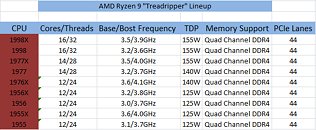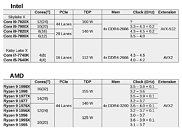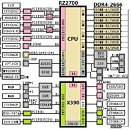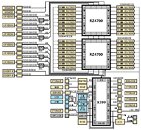Monday, May 15th 2017

AMD Ryzen 9 "Threadripper" Lineup Leaked
Today is an eventful day in the tech world, with two high-impact leaks already offering themselves up to our scrutiny. We had previously covered AMD's upcoming HEDT platform, based on the company's new X399 chipset, as having a quite distinctive lineup of processors, with not only 16 and 12-core offerings hot on foundries presses', but also some 14-core, 28-thread chips as well. Now, a leak has apparently revealed the entire Ryzen HEDT platform, whose processor marketing name, Ryzen 9, sounds really close to Intel's Core i9.
AMD's offerings look to offer an edge at least on core-count, with the Red team's top offerings, the Ryzen 9 1998X and Ryzen 9 1998, bringing in a game-changer 16 cores and 32 threads to the table. Perhaps even more importantly, we have to mention that the 1998X (these names, if true, are quite a mouthful, though) achieves a 3.5 GHz base, 3.9 GHz boost clock, which owes nothing to AMD's Ryzen 7 1800X consumer flagship CPUs. Rumors of AMD's frequency demise on higher core-count Ryzen CPUs have been greatly exaggerated, it would seem. And did I mention that these chips are coming with a TDP of 155 W - 5 W lower than Intel's purported 12-core, i9-7920X offering? Consider that for a moment.The 14-core parts are reported to be the Ryzen 9 1977X and Ryzen 9 1977. The Ryzen 9 1977X is a 155 W 14-core, 28-thread processor with a base clock speed of 3.5 GHz and a boost clock speed of 4.1 GHz with XFR. The Ryzen 9 1977 brings those speeds down a bit towards 3.2 GHz base and 3.7 GHz boost, with a correspondingly lower TDP of 140 W.
On to the 12-core parts, three different processors are expected: the Ryzen 9 1976X, Ryzen 9 1956X and the Ryzen 9 1956 (strange naming scheme with that 2-algharism difference between two parts with the same number of cores, I'd say.) The Ryzen 9 1976X is a 12-core, 24-thread, 140 W part, with a base clock 3.6 GHz and a boost clock speed of 4.1 GHz with XFR; the Ryzen 9 1956X lowers the TDP to just 125 W, on account of a lower base clock speed of 3.2 GHz and a boost clock speed of 3.8 GHz with XFR. The entry level 12 core part, the 1956, is rated at the same 125 W while running at a base clock speed of 3.0 GHz and a boost clock speed of 3.7 GHz.
There are also supposed to be two 10-core CPUs in this lineup, both rated at 125 W. The Ryzen 9 1955X, which runs at 3.6 GHZ base, and 4.0 GHz boost with XFR, and the Ryzen 9 1955, which runs at a base clock of 3.1 GHz and a 3.7 GHz boost.
I have to say, AMD is doing an amazing job with its Ryzen lineup, and the absolutely bonkers core-count on this X399, Whitehaven platform is most likely than not run circles around its Intel counterparts. Gone are the days of AMD's higher core count at the expense of computational power and IPC; as we've seen, AMD's Ryzen has achieved a great enough boost to its IPC that it can leverage its higher number, svelter cores over Intel's architecture, with absolutely mind-blowing TDP numbers (really, take another look at those TDPs in comparison to Intel's Core i9 series.)AMD's Whitehaven platform looks to be an attractive prospect. Let's just hope AMD's platform stability and compatibility quirks are fully ironed-out until the expected June release.
Source:
WCCFTech
AMD's offerings look to offer an edge at least on core-count, with the Red team's top offerings, the Ryzen 9 1998X and Ryzen 9 1998, bringing in a game-changer 16 cores and 32 threads to the table. Perhaps even more importantly, we have to mention that the 1998X (these names, if true, are quite a mouthful, though) achieves a 3.5 GHz base, 3.9 GHz boost clock, which owes nothing to AMD's Ryzen 7 1800X consumer flagship CPUs. Rumors of AMD's frequency demise on higher core-count Ryzen CPUs have been greatly exaggerated, it would seem. And did I mention that these chips are coming with a TDP of 155 W - 5 W lower than Intel's purported 12-core, i9-7920X offering? Consider that for a moment.The 14-core parts are reported to be the Ryzen 9 1977X and Ryzen 9 1977. The Ryzen 9 1977X is a 155 W 14-core, 28-thread processor with a base clock speed of 3.5 GHz and a boost clock speed of 4.1 GHz with XFR. The Ryzen 9 1977 brings those speeds down a bit towards 3.2 GHz base and 3.7 GHz boost, with a correspondingly lower TDP of 140 W.
On to the 12-core parts, three different processors are expected: the Ryzen 9 1976X, Ryzen 9 1956X and the Ryzen 9 1956 (strange naming scheme with that 2-algharism difference between two parts with the same number of cores, I'd say.) The Ryzen 9 1976X is a 12-core, 24-thread, 140 W part, with a base clock 3.6 GHz and a boost clock speed of 4.1 GHz with XFR; the Ryzen 9 1956X lowers the TDP to just 125 W, on account of a lower base clock speed of 3.2 GHz and a boost clock speed of 3.8 GHz with XFR. The entry level 12 core part, the 1956, is rated at the same 125 W while running at a base clock speed of 3.0 GHz and a boost clock speed of 3.7 GHz.
There are also supposed to be two 10-core CPUs in this lineup, both rated at 125 W. The Ryzen 9 1955X, which runs at 3.6 GHZ base, and 4.0 GHz boost with XFR, and the Ryzen 9 1955, which runs at a base clock of 3.1 GHz and a 3.7 GHz boost.
I have to say, AMD is doing an amazing job with its Ryzen lineup, and the absolutely bonkers core-count on this X399, Whitehaven platform is most likely than not run circles around its Intel counterparts. Gone are the days of AMD's higher core count at the expense of computational power and IPC; as we've seen, AMD's Ryzen has achieved a great enough boost to its IPC that it can leverage its higher number, svelter cores over Intel's architecture, with absolutely mind-blowing TDP numbers (really, take another look at those TDPs in comparison to Intel's Core i9 series.)AMD's Whitehaven platform looks to be an attractive prospect. Let's just hope AMD's platform stability and compatibility quirks are fully ironed-out until the expected June release.





83 Comments on AMD Ryzen 9 "Threadripper" Lineup Leaked
AMD is really betting it all on Ryzen. And they have some really good stuff.
Then there's Ryzen which is similar to Conroe in that it has shaken the entire x86 landscape, atm if you want a cheap 6/8 core them AMD is your best bet. The competition will probably bring better priced alternatives, though on the VFM scale AMD will continue to rule.
So far, everything has played fine. When I am rendering, I use 54 threads and leave 4 threads for my own usage, like browsing and gaming.
The R9 is looking to take a large bite off the Intel marketshare, customers who previously bought 5960x or 6950x, it shouldn't take much to sway them towards AMD provided single threaded performance isn't their biggest concern. Though the inter CCX latency would be interesting to watch, especially with Naples said to be the bread & butter for future AMD revenue & especially profits.
Asshat statement from a tool ,ipc isn't magic ,it takes clock speed or more resources ala Alu etc ,more cores Is more resources and I assure you mine would graft all of every day.
Now all we need is for these 16-core monsters to be attractively priced with Intel's HEDT CPU's and we've got a good thing going! :cool:
although at the cost of TDP, you can have your 5ghz 4core 8 thread cpu that is the same in raw performance as a 3ghz 8 core part at the cost of Twice the power consumption.
ryzen 1800X 3.6 ghz 8c/16t = I7 7700K 4.2ghz in power consumption
multithreaded performance is the only way one is capable of getting more performance quickly and effeciently.
Core wars was started by AMD with dualcore (although at the time AMD was IPC leaders), intel expanded with 4-6-8-10 and 12 core parts way before AMD started selling cores like they did with bulldozer.
Intel is also the leader in the IPC and singlethreaded performance.
I doubt every single CPU maker out there regardless of architecture is mistaken that adding cores is the logical thing to do, the 1800x vs 7700K is a great example of efficiency with cores :)
I think Threadripper would be an excellent name for the Series.
Threadripper 1 Extreme = T1E
Threadripper 1 Apex = T1A
AMD buyers desperately need more ROG board choices other than the one Crosshair VI Hero, C6H.
...although I would guess ROG is extremely busy right about now, so many new boards to produce, for the red and the blue.
Believe I'll go with the R6E and an 8-core or the T1E and a 12-core.
Keep that HEDT news coming Lord Ravenholm! :p
"We don't go to Ravenholm!":roll:
I don't think people should be allowed to buy million pound supercars because it's not fair that i cant have one ,that and have you seen uk roads they are wasted here , what's the point.
You can now get a 6/8 core cpu cheaper than before , that's competition right there.
You are arguing a pointless point in as confused a way as I've ever seen.
They should Not stop competing in those grounds, intel have been selling 12+ core chips upto a few thousand pounds a pop Waaaaaaaay too long.
You sir are probably in the wrong forum ,most here are tech enthusiasts ,moar and faster is always better.
And just because your pc sits doing nowt eternally until you have your weekend round of csgo , don't think you know what others do with theirs ,or need.
And I don't think most pcs in use are gaming.
Intel platform has a much wider choice of processors.
The ones that compete with the shown Ryzen 9 variants also have 44 PCIe lanes.Yes, yes - you're so awesome and pro. I'm doing something that could be called "real work" and a lot of it is single threaded. What about that?
Also: distributed computing is hardly "real work". You're just lending your processing power. Don't build a life philosophy around it.
You, sir, deserve a cookie! :toast:
Also, quad-channel memory is particularly effective with programs that perform Finite Element Analysis.